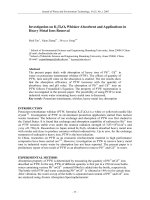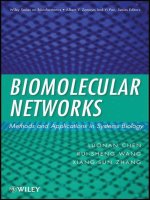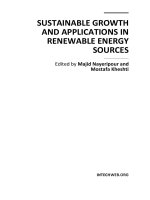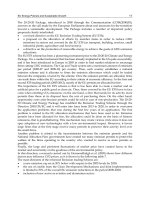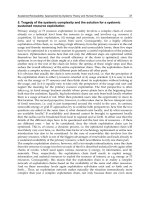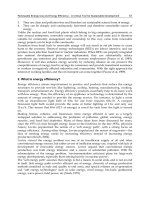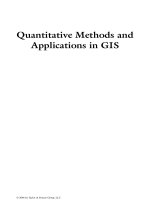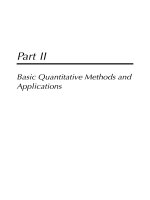Conserved gene cluster discovery and applications in comparative genomics
Bạn đang xem bản rút gọn của tài liệu. Xem và tải ngay bản đầy đủ của tài liệu tại đây (952.65 KB, 124 trang )
CONSERVED GENE CLUSTER
DISCOVERY AND APPLICATIONS
IN COMPARATIVE GENOMICS
MELVIN ZHANG
(B. Comp (Hons), NUS)
A THESIS SUBMITTED
FOR THE DEGREE OF DOCTOR OF PHILOSOPHY
SCHOOL OF COMPUTING
NATIONAL UNIVERSITY OF SINGAPORE
2011
ii
Acknowledgement
I would like to take this opportunity to express my gratitude to my advisor,
Associate Professor Hon Wai Leong. Hon Wai not only gave me valuable advice
on research directions and methodology, he also exposed me to the other facets of
academia, such as teaching, peer review, and networking. In particular, I’m very
grateful for the opportunity to visit and work with researchers from the CAS-MPG
Partner Institute of Computation Biology (PICB) in Shanghai.
I am also grateful to Dr Guillaume Bourque, Professor Lim Soon Wong, and
Associate Professor Ken Sung. Guillaume and Hon Wai jointly proposed a project
on genome rearrangements which became my final year project. Working on this
project sparked my interest in research and lead me to purse graduate studies at
NUS. During my candidature, my thesis advisory committee members, Lim Soon
and Ken, provided invaluable feedback on how to improve the strength and impact
of my research.
In the course of my candidature, I had the wonderful opportunity to work with
a number of students and researchers. I would like to thank my collaborators: Dr
Xingguang Zhu, Dr Axel Mosig, Zhu Liang, Xiao Hang, Fan Chang, Cao Fan,
Trong Dao Le, and Zhou Zhong.
Lastly, I would like to thank my family, friends, and members of NUS RAS
Group (Ket Fah Chong, Francis Ng, Ning Kang, Max Tan, and Sriganesh) for
their continual encouragement and support.
iii
iv
Contents
Acknowledgement iii
Summary ix
List of Tables xi
List of Figures xii
1 Introduction 1
1.1 Motivation . . . . . . . . . . . . . . . . . . . . . . . . . . . . . . . . 3
1.2 Thesis Organization and Contributions . . . . . . . . . . . . . . . . 6
2 Literature Review 9
2.1 Basic Definitions and Notations . . . . . . . . . . . . . . . . . . . . 9
2.2 Models and Algorithms for Conserved Gene Clusters Discovery . . . 10
2.2.1 Common Intervals and Conserved Intervals . . . . . . . . . . 11
2.2.2 Gene Teams . . . . . . . . . . . . . . . . . . . . . . . . . . . 14
2.2.3 r-window Clusters . . . . . . . . . . . . . . . . . . . . . . . 17
2.2.4 Discussion . . . . . . . . . . . . . . . . . . . . . . . . . . . . 18
2.3 Algorithms for the Ortholog Assignment Problem . . . . . . . . . . 19
2.3.1 Distance minimization . . . . . . . . . . . . . . . . . . . . . 19
2.3.2 Similarity maximization . . . . . . . . . . . . . . . . . . . . 20
2.3.3 Heuristics/rule-based . . . . . . . . . . . . . . . . . . . . . . 20
2.3.4 Discussion . . . . . . . . . . . . . . . . . . . . . . . . . . . . 21
v
Contents vi
3 A Parameter-Free Max-Gap Gene Cluster Model 23
3.1 Motivation . . . . . . . . . . . . . . . . . . . . . . . . . . . . . . . . 24
3.2 Problem Definition . . . . . . . . . . . . . . . . . . . . . . . . . . . 25
3.2.1 Notations and definitions . . . . . . . . . . . . . . . . . . . . 25
3.2.2 The AllGeneTeams problem . . . . . . . . . . . . . . . . 26
3.3 Gene Team Tree Model and Algorithms . . . . . . . . . . . . . . . . 26
3.3.1 A motivating example . . . . . . . . . . . . . . . . . . . . . 27
3.3.2 Gene Team Tree (GTT) . . . . . . . . . . . . . . . . . . . . 27
3.3.3 Properties of the GTT . . . . . . . . . . . . . . . . . . . . . 28
3.3.4 Algorithm SimpleGTT . . . . . . . . . . . . . . . . . . . . 30
3.3.5 Correctness of SimpleGTT . . . . . . . . . . . . . . . . . . 31
3.3.6 Time Complexity of SimpleGTT . . . . . . . . . . . . . . . 32
3.3.7 Algorithm FastGTT: Speeding up SimpleGTT . . . . . . 33
3.3.8 Handling multiple chromosomes . . . . . . . . . . . . . . . . 35
3.4 Experimental Results . . . . . . . . . . . . . . . . . . . . . . . . . . 36
3.4.1 E. coli K-12 and B. subtilis Dataset . . . . . . . . . . . . . . 36
3.4.2 Gamma-Proteobacteria Dataset . . . . . . . . . . . . . . . . 41
3.4.3 Human and Mouse Dataset . . . . . . . . . . . . . . . . . . 44
3.5 Conclusion and Extensions . . . . . . . . . . . . . . . . . . . . . . . 46
4 A Constrained Max-Length Gene Cluster Model 49
4.1 Motivation . . . . . . . . . . . . . . . . . . . . . . . . . . . . . . . . 49
4.2 The BBH r-window Gene Cluster Mining Problem . . . . . . . . . . 51
4.3 A Generic Algorithmic Framework for BBH r-window Gene Cluster
Mining . . . . . . . . . . . . . . . . . . . . . . . . . . . . . . . . . . 53
4.3.1 Finding best hits with a sliding window algorithm . . . . . . 53
4.4 BBHRW using similarity measure count . . . . . . . . . . . . . . . 56
4.4.1 Similarity measure count . . . . . . . . . . . . . . . . . . . 56
4.4.2 Algorithm SWBST . . . . . . . . . . . . . . . . . . . . . . . 56
4.4.3 Time complexity analysis of algorithm SWBST . . . . . . . 59
Contents vii
4.4.4 Results and discussion . . . . . . . . . . . . . . . . . . . . . 60
4.5 BBHRW using similarity measure msint . . . . . . . . . . . . . . . 63
4.5.1 Similarity measure msint . . . . . . . . . . . . . . . . . . . 63
4.5.2 Algorithm SWOT . . . . . . . . . . . . . . . . . . . . . . . . 64
4.5.3 Time complexity analysis of algorithm SWOT . . . . . . . . 66
4.5.4 Results and Discussion . . . . . . . . . . . . . . . . . . . . . 67
4.6 Comparison between BBHRW (count) and Gene Team . . . . . . 71
4.7 Conclusion . . . . . . . . . . . . . . . . . . . . . . . . . . . . . . . . 74
5 Ortholog Assignment based on Sequence and Spatial Similarity 77
5.1 Motivation . . . . . . . . . . . . . . . . . . . . . . . . . . . . . . . . 77
5.2 Inferring Positional Homologs as Bidirectional Best Hits of Sequence
and Gene Context Similarity . . . . . . . . . . . . . . . . . . . . . . 79
5.2.1 Computing sequence similarity scores . . . . . . . . . . . . . 80
5.2.2 Computing gene context similarity scores . . . . . . . . . . . 81
5.2.3 Combining bidirectional best hits . . . . . . . . . . . . . . . 83
5.2.4 Reducing the number of false positives . . . . . . . . . . . . 83
5.3 Results and Discussion . . . . . . . . . . . . . . . . . . . . . . . . . 84
5.3.1 Experimental setup . . . . . . . . . . . . . . . . . . . . . . . 84
5.3.2 Parameter tuning for BBH-LS . . . . . . . . . . . . . . . . . 85
5.3.3 Comparison of BBH-LS against existing methods . . . . . . 88
5.4 Conclusion . . . . . . . . . . . . . . . . . . . . . . . . . . . . . . . . 91
6 Conclusion 93
6.1 Summary of Contributions . . . . . . . . . . . . . . . . . . . . . . . 93
6.2 Future Work . . . . . . . . . . . . . . . . . . . . . . . . . . . . . . . 94
A Other research work undertaken during the candidature 107
A.1 Phylogeny from Gene Order Web Application . . . . . . . . . . . . 107
A.2 On Two Variations of the Reversal Median Problem . . . . . . . . . 108
Contents viii
A.3 Dynamic Programming Algorithms for Efficiently Computing Coseg-
mentation between Biological Images . . . . . . . . . . . . . . . . . 108
A.4 Ortholog Assignment for Plant Genomes . . . . . . . . . . . . . . . 109
A.5 Genome Sorting with Bridges . . . . . . . . . . . . . . . . . . . . . 109
Summary
We share the vast majority of our genes with the great apes, our closest living
relative. However, how the genes are arranged is quite different. We have 23
pairs of chromosomes, whereas other great apes have 24 pairs; our chromosome 2
was formed by the fusion of two ancestral chromosomes. We have at least nine
chromosomal regions that are inverted in chimpanzees. Fusions, inversions and
other rearrangements result in a “shuffling” of the genes. Conserved gene clusters
are sets of genes that can be found near one another in several species despite
these rearrangements. They may result from functional pressure to keep these
genes close together or a lack of rearrangements. In either case, conserved gene
clusters provide information for inferring gene function and better understanding
of genome evolution.
In the first part of this thesis, we propose new gene cluster models
that make use of biological constraints or structural properties to reduce
the number of parameters. We then develop efficient algorithms to
identify gene clusters based on our models. The second part of this
thesis, studies the conservation of individual genes, also known as the
Ortholog Assignment problem. For this problem, many sophisticated
methods have been proposed. Our contribution is a simple yet effective
method that integrates sequence and gene context similarity in a single
framework.
Max-gap clusters (aka gene teams) is a popular model of conserved gene clus-
ters. This model uses a max-gap parameter δ to restrict the maximum distance
ix
Contents x
between adjacent genes in a cluster. In practice, determining an ideal value of δ is
a matter of trial and error. We proposed the Gene Team Tree (GTT) structure as
a compact representation of gene teams for all possible values of δ. Surprisingly, we
were able to extend algorithms for finding gene teams, based on a specific value of
δ, to compute the GTT without increasing the time/space complexity. We applied
our model to compute the GTT for E. coli K-12 and B. subtilis and confirmed
that known E. coli K-12 operons corresponds to gene teams with different values
of δ
Max-length clusters (aka r-window clusters) is a different gene cluster model
where a cluster has length at most r and contains at least k genes. The bidi-
rectional best hit (BBH) heuristic is widely used in sequence analysis to identify
putative homologous genes. As conserved gene clusters are a generalization of
homologous genes, we proposed to use the BBH heuristic to identify conserved
r-window clusters. We name this new model bidirectional best hit r-window model
(BBHRW) and designed a sub-quadratic time algorithm to find all clusters. We
investigated how well the gene clusters modelled by the two models corresponds
to known E. coli K-12 operons. We found that the two model are complementary;
the gene team model has more clusters that corresponds to operons, while the
BBHRW model has fewer clusters that do not correspond to any operon.
We also studied the problem of identifying individual conserved genes, the so
called Ortholog Assignment problem. Several sophisticated methods exists
for this problem. Our contribution is a simple yet effective method (BBH-LS) to
identify positional homologs. BBH-LS applies the bidirectional best hit heuris-
tic to a combination of sequence similarity and gene context similarity scores.
We applied BBH-LS to the human, mouse, and rat genomes and found that the
best results are obtained when using both sequence and gene context information
equally. In our comparisons, BBH-LS reported the largest number of true positives
and a medium number of false positives.
List of Tables
1.1 Effect of rearrangements on gene order and gene content . . . . . . 5
2.1 Summary of algorithms for finding all common/conserved intervals,
m is the number of input gene orders, n is the length of each gene
order, and z is the output size . . . . . . . . . . . . . . . . . . . . . 12
3.1 Number of genes and gene families in the E. coli K-12 and B. subtilis
dataset. A common gene family is a gene family that is present in
both genomes. . . . . . . . . . . . . . . . . . . . . . . . . . . . . . . 37
3.2 Sizes of the input and output for the five datasets and their running
time (denoted by t). . . . . . . . . . . . . . . . . . . . . . . . . . . 42
4.1 Significant BBHRW (count) clusters and corresponding operons.
Nine out of the top twelve based on log E value and correspond-
ing operons. Numbers in brackets indicate number of genes in the
cluster over number of genes in the operon. . . . . . . . . . . . . . . 62
xi
List of Tables xii
List of Figures
1.1 Number of base pairs stored in NCBI’s GenBank database as a func-
tion of time. Created by user 121a0012 on Wikipedia and released
into public domain. . . . . . . . . . . . . . . . . . . . . . . . . . . . 2
1.2 The gene tree for three genes g, h, and h
that descended from a
single ancestral gene in the most recent common ancestor (MRCA)
of genome G and H. Gene g is orthologous to both h and h
, but
only g and h are positional homologs because h is the original gene
that was duplicated to get h
. Genes h and h
are paralogs as they
are separated by a duplication event. . . . . . . . . . . . . . . . . . 4
3.1 GTT for a
1
, b
2
, a
6
, c
8
, b
9
and c
1
, c
4
, b
5
, a
6
, b
8
, b
9
. The value of δ
used to split each gene team is shown in subscripts. . . . . . . . . . 28
3.2 GTT for E. coli K-12 and B. subtilis showing gene teams with at
least 10 families. The number in each node of the tree represents
the number of families in the corresponding gene team. . . . . . . . 38
3.3 Number of identified operons for different values of the Jaccard
score threshold. . . . . . . . . . . . . . . . . . . . . . . . . . . . . . 40
3.4 Number of identified operons for different values of the max-gap
parameter, δ. The dashed line indicates the value of δ suggested in
He and Goldwasser [2005] for this dataset. . . . . . . . . . . . . . . 40
3.5 Phylogeny of the gamma-proteobacteria from Lerat et al. [2003].
Marked species are included in our study. . . . . . . . . . . . . . . . 41
3.6 Number of identified operons for different values of the Jaccard
score threshold for each of the five input tuples. . . . . . . . . . . . 43
3.7 Number of identified operons over number of identifiable operons
for each of the five input tuples based on a Jaccard score threshold
of 2/3. . . . . . . . . . . . . . . . . . . . . . . . . . . . . . . . . . . 43
xiii
List of Figures xiv
3.8 Subtree of the GTT for human and mouse genomes containing genes
from chromosome X. Due to space limitations, only gene teams with
at least 3 families are shown. . . . . . . . . . . . . . . . . . . . . . . 45
4.1 The nodes with bold outline are visited by Algorithm 6 during a
range query on the interval [1, 5]. . . . . . . . . . . . . . . . . . . . 58
4.2 Number of identified operons versus Jaccard score threshold for
BBHRW (count, r = 6) clusters. . . . . . . . . . . . . . . . . . . . 61
4.3 Percentage of identified operons and percentage of non-operon clus-
ters versus maximum window length for the BBHRW (count) model. 62
4.4 The update intervals corresponding to each gene in H = a, b, a, b, b, c
with the red line representing largest overlap with respect to w
G
=
a, b, b and r = 5. There is no update interval for gene c since it
does not occur in w
G
. . . . . . . . . . . . . . . . . . . . . . . . . . . 66
4.5 Comparison of the running time between the na¨ıve algorithm, al-
gorithm SWBST and algorithm SWOT for the two similarity mea-
sures, count (left) and msint (right). Note that algorithm SWBST
cannot be used for similarity measure msint. . . . . . . . . . . . . . 67
4.6 Number of reported BBHRW clusters for both similarity measures
and r varying from 1 to 30. . . . . . . . . . . . . . . . . . . . . . . 68
4.7 Percentage of identified operons and percentage of non-operon clus-
ters versus maximum window length for both variants of the BBHRW
model. . . . . . . . . . . . . . . . . . . . . . . . . . . . . . . . . . . 69
4.8 Precision versus recall curve for BBHRW (count, r = 6) and BBHRW
(msint, r = 8) clusters for the identification of E. coli K-12 operons. 71
4.9 Percentage of identified operons and percentage of non-operon clus-
ters versus maximum distance between adjacent genes in a team for
the gene team model. . . . . . . . . . . . . . . . . . . . . . . . . . . 72
4.10 Venn diagram showing the overlap between the operons identified
based our BBHRW (count) model and the gene team model for a
single parameter value (r = 6, δ = 3) and over a range of parameter
values (r ∈ [1, 30], δ ∈ [1, 32]). . . . . . . . . . . . . . . . . . . . . . 72
4.11 Precision versus recall curve for BBHRW (count, r = 6) and gene
teams (δ = 3) for identification of E. coli K-12 operons. . . . . . . . 73
5.1 Conserved synteny blocks between human and mouse genome gen-
erated by the Cinteny web server [Sinha and Meller, 2007] . . . . . 80
List of Figures xv
5.2 Computing the local synteny score for g and h. We consider three
genes upstream and downstream of the two genes of interest and
add an edge between two genes if their BLASTP E-value is less than
1e
−5
. The thick edges show one of the possible maximum matching.
The local synteny score of g and h is 4 since there are 4 edges in
the maximum matching. . . . . . . . . . . . . . . . . . . . . . . . . 82
5.3 Performance of BBH-LS for different weight of gene context simi-
larity to sequence similarity on the human-mouse dataset. Left axis
indicates the number of pairs of true positives and the right axis
indicate the number of unknown pairs and false positives. . . . . . . 86
5.4 Performance of BBH-LS for different weight of gene context sim-
ilarity to sequence similarity on the mouse-rat dataset. Left axis
indicates the number of pairs of true positives and the right axis
indicate the number of unknown pairs and false positives. . . . . . . 86
5.5 Performance of BBH-LS for different strength threshold β on the
human-mouse dataset. Left axis indicates the number of pairs of
true positives and the right axis indicate the number of unknown
pairs and false positives. . . . . . . . . . . . . . . . . . . . . . . . . 88
5.6 Plot of number of true positives vs number of false positives in the
output of BBH-LS (α = 0.50, β = 0.00), BBH, MSOAR2, InPara-
noid, OMA, and Ensembl Compara for the human-mouse, human-
rat, and mouse-rat dataset . . . . . . . . . . . . . . . . . . . . . . 89
5.7 Venn diagram showing the overlap between the true positives re-
ported by BBH-LS, MSOAR2, and InParanoid for the human-mouse
dataset. . . . . . . . . . . . . . . . . . . . . . . . . . . . . . . . . . 90
5.8 BBH erroneously paired RASGRF2 (human) to RASGRF1 (mouse)
because of high Smith-Waterman score, this was corrected by BBH-
LS with the help of local synteny score. Bold edges are the pairing
from BBH-LS, thin edges are the pairing from BBH, sw = Smith-
Waterman score, lc = local synteny score . . . . . . . . . . . . . . . 91
5.9 BBH-LS paired LILRA5 (human) with PIRA5 (mouse) and LAIR2
(human) with LIRA5 (mouse) due to the high local synteny pro-
duced by the five pairs of genes in between. The correct pairing
should be LILRA5 (human) with LILRA5 (mouse) and this was
picked up by BBH using just the normalized Smith-Waterman score. 91
Chapter 1
Introduction
The genome of an organism is the combined hereditary information that is found
in every cell of the organism. To a large extent, this information represents the
“nature” in the classical nature versus nurture debate. In our case, our genome is
stored in 23 pairs of chromosomes. Each chromosome is a long chain composed of
four different types of deoxyribonucleic acid (DNA) molecules, giving us (and most
other species) a four letter genetic code. One of the early successes of Computa-
tional Biology (the application of computational techniques for solving biological
problems) is the early completion of the Human Genome Project [Collins et al.,
1998]. The initial goal of the project is to determine every letter of our genome.
This is also commonly known as the sequencing of the human genome. Sequencing
machines can only sequence short fragments reliably, scaling them up to handle
the over three billion letters in our genome was an insurmountable task. Sophis-
ticated algorithms that are able to computationally assemble small fragments of
overlapping DNA sequences enabled bold new strategies based on randomly break-
ing many copies of the genome into overlapping short fragments and using existing
machines to sequence these short fragments in parallel [Venter et al., 1998].
Since then, enhancements to the computational algorithms for assembly and
improvements to the underlying sequencing hardware has enabled us to sequence
1
Chapter 1. Introduction 2
Fig. 1.1: Number of base pairs stored in NCBI’s GenBank database as a function
of time. Created by user 121a0012 on Wikipedia and released into public domain.
more and more species. The rate at which new sequences are being produced fol-
lows an exponential growth reminiscent of Moore’s Law (see Figure 1.1). As more
and more complete genomes have been sequenced, the emphasis in Computational
Biology is shifting toward understanding and interpreting the information encoded
in these genomes.
Traditional wet lab techniques cannot keep up with the deluge of genome
sequences. A promising approach to gain some initial understanding of a newly
sequenced genome is to compare it with well studied genomes such as the human
genome. This comparative approach to genomics exemplifies the principle behind
the field of Comparative Genomics. Such a strategy requires us to be able to
identify identify conserved elements across species boundaries [Koonin, 2005]. In
this thesis, we consider two classes of conserved elements: individual genes and
sets of genes.
Chapter 1. Introduction 3
1.1 Motivation
A gene is a segment of our genome that gets translated into proteins. Proteins
are long polymers that can fold into intricate three dimensional structures to act
as nano machines. Thus, we can think of genes as the blueprint for making these
biological nano machines.
A central problem in Comparative Genomics is to identify homologous genes.
These are genes that are descended from the single ancestral gene in the most
recent common ancestor [Fitch, 2000]. This is an important task because homolo-
gous genes typically perform similar functions and any whole genome comparison
would first need to establish the set of homologous genes [Koonin, 2005].
This is a non-trivial problem because the DNA sequence of genes are altered by
mutations of the genome that changes the letters in the sequence or inserts/deletes
letters from the sequence of the gene. Genes can also be duplicated, therefore
different copies of a single ancestral gene may exists in different species. Finally
genes may be lost if it accumulates so many mutations that it is no longer able to
perform its function.
Homologous genes can be further divided into orthologs and paralogs. Or-
thologs are genes separated by a speciation event, while paralogs are genes sepa-
rated by a duplication event. Figure 1.2 shows the family tree of three homologous
genes superimposed on top of the species tree.
Ideally, we would like to establish one-to-one correspondences between genes
in different species. This greatly simplify certain tasks such as transfer of function
annotation [Friedberg, 2006] and genome rearrangement studies [Sankoff, 1999].
Unfortunately, orthologs are not necessarily one-to-one due to gene duplication.
The Ortholog Assignment problem was proposed in Fu et al. [2007] to
identify for each ancestral gene, a single descendant gene in each species that
best reflects the position of the ancestral gene. We call these genes positional
homologs, following the terminology of Burgetz et al. [2006]. A similar problem
called the Exemplar problem was proposed earlier in Sankoff [1999] in the context
Chapter 1. Introduction 4
MRCA of G and H
G
H
speciation
duplication
positional homologs
orthologs
g
h
h
paralogs
Fig. 1.2: The gene tree for three genes g, h, and h
that descended from a single
ancestral gene in the most recent common ancestor (MRCA) of genome G and H.
Gene g is orthologous to both h and h
, but only g and h are positional homologs
because h is the original gene that was duplicated to get h
. Genes h and h
are
paralogs as they are separated by a duplication event.
of computing the genomic distance between gene orders. The Exemplar problem
can be considered to be a approach for solving the Ortholog Assignment
problem based on minimizing the genomic distance.
Assuming we have identified which are the homologous genes, we can start to
consider conservation on a larger scale. A natural generalization is to consider sets
of genes. What does it mean for a set of genes to be conserved? First, we have to
understand the mutation events that affect whole segment of genes at once.
Table 1.1 show how the order of genes in a chromosome (gene order) is affected
by different kinds of large scale mutations, also known as rearrangements. We
represent genes by letters.
These large-scale mutations or rearrangements are relatively rare but they
affect the content and order of the genomes, thereby obscuring the relationship
between species [Sankoff, 2003]. These rearrangements are not entirely arbitrary
as selective pressure removes those rearrangements which are fatal to the organism.
Chapter 1. Introduction 5
Type of rearrangement Effect on gene order
Reversal a b c d e ⇒ a b e d c
Transposition a b c d e ⇒ a c d e b
Inverted transposition a b c d e ⇒ a e d c b
Insertion a b c d e ⇒ a b f c d e
Duplication a b c d e ⇒ a b a c d e
Deletion a b c d e ⇒ a b d e
Table 1.1: Effect of rearrangements on gene order and gene content
As a result, over time regions of the genome which are not functionally related
tend to accumulate more rearrangements as compared to regions which contains
functionally dependent genes.
When comparing the genomes of several species, we can identify relatively
compact regions in different species that have the same set of homologous genes.
These genes managed to stay in close proximity to one another despite the re-
arrangements. As they are found in several species (conserved) and located in a
compact region (clustered), we call them conserved gene clusters.
One possible reason for the existence of these clusters is that any rearrangement
that disrupts the cluster is deleterious to the organism. This implies some kind of
functional dependency among the genes in a cluster. In fact, Overbeek et al. [1999]
showed that it is possible to infer functional coupling between genes based on the
fact that they are part of some conserved clusters. In the study of prokaryotic
genomes such as that of bacteria, conserved gene clusters is used in predicting
operons [Ermolaeva et al., 2001] and detecting horizontal transfers [Lawrence,
1999].
Another reason why such clusters are observed is simply because not enough
rearrangements have occurred since the species diverged. In either case, the clus-
ters reflect the organization of these genes in the most recent common ancestor.
Thus, conserved gene clusters are used to infer the gene order of the ancestral
genome [Bergeron et al., 2004]. Establishing the number and size of conserved
gene clusters between two genomes also provides an estimate of the similarity be-
tween two genomes. One approach for the Ortholog Assignment problem is to
Chapter 1. Introduction 6
select the gene pairs to maximize the similarity based on conserved gene clusters
Bourque et al. [2005], Blin et al. [2006].
Lastly, the study of conserved gene clusters is also interesting from an algo-
rithmic point of view. In most models of conserved gene clusters, the order of
the genes does not matter. This gives rise to a new class of string problems that
focuses on the character sets of substrings [Uno and Yagiura, 2000, B´eal et al.,
2004, Heber et al., 2011].
1.2 Thesis Organization and Contributions
The rest of this thesis is organized as follows. In Chapter 2, we summarize the
related work for Conserved Gene Cluster Discovery and the Ortholog
Assignment problem and discusses how it leads to our work. Chapters 3, 4, and
5 then presents the main contributions of thesis.
In Chapter 3, we introduce our Gene Team Tree (GTT) model, which is a
parameter-free hierarchical representation of gene teams for all gap lengths. Gene
team is a model for conserved gene clusters that allows for a gap of length at
most δ within a cluster. In practice, determining an ideal value of δ is a matter
of trial and error. Even worse, there is often no one single “best” value of δ. We
propose to eliminate the parameter and simply compute all possible gene teams.
It turns out to be possible to do this with the same worst case time complexity
as computing the gene team for a specific δ and the computed teams can be
represented hierarchically. We compute the GTT for E. coli K-12 and B. subtilis
and confirmed that known E. coli K-12 operons corresponds to gene teams with
different values of δ.
In Chapter 4, we investigated the use of the bidirectional best hit heuristic
from sequence analysis for the purpose of identifying conserved gene clusters based
on the r-window model. We call this new model bidirectional best hit r-window
model (BBHRW) and designed a sub-quadratic time algorithm to find all clusters.
Chapter 1. Introduction 7
We studied how well does the gene clusters modelled by BBHRW and gene team
corresponds to known E. coli K-12 operons. We found that the two model are
complementary; the gene team model has more clusters that corresponds to oper-
ons, while the BBHRW model has fewer clusters that do not correspond to any
operon. When we rank both sets of clusters and plot their precision and recall, we
found that BBHRW model has a higher precision at all levels of recall as compared
to the gene team model.
In Chapter 5, we studied the identification of conserved genes based on the
Ortholog Assignment problem. We present a simple yet effective method
(BBH-LS) for the identification of positional homologs from the comparative anal-
ysis of two genomes. BBH-LS applies the bidirectional best hit heuristic to a com-
bination of sequence similarity and gene context similarity scores. We applied our
method to the human, mouse, and rat genomes and found that BBH-LS produced
the best results when using both sequence and gene context information equally.
In our comparisons, BBH-LS reported the largest number of true positives and a
medium level of false positives as compared to state-of-the-art methods.
We conclude and present a number of open issues in Chapter 6.
Chapter 1. Introduction 8
Chapter 2
Literature Review
In this chapter, we review the related literature and define some common nota-
tions and definitions to make the subsequent discussion more concise. We first
review the existing models and algorithms for the Conserved Gene Cluster
Discovery problem and discuss some of the issues which we addressed in our
work. This is followed by a review and discussion of methods for the Ortholog
Assignment problem.
This is an extension of the abstract “Survey of Algorithms for Conserved Gene
Clusters Discovery” presented at the Asian Association for Algorithms and Com-
putation (AAAC), 2011.
2.1 Basic Definitions and Notations
Our model of a genome is as a sequence of genomic markers for which homology
information across the genomes of interest are available. The most common and
well annotated type of genomic markers are protein coding genes. Henceforth,
we will refer to these genomic elements as genes. The methods developed in this
thesis work equally well with any kind of genomic feature that is conserved.
A notion that is central for identifying gene clusters is the relationship between
genes. In particular, we need to identify genes from different species that have
evolved from a common ancestral gene. Such a collection of genes is known as a
9
Chapter 2. Literature Review 10
gene family [Fitch, 2000].
Definition 1 (Genes and gene families). Let Σ denote the set of gene families. A
gene, g, is part of a gene family denoted as fam(g). Furthermore, a gene g in a
genome G has a unique location on the genome that starts at start(g) and ends at
end(g). We represent a gene g textually as fam(g)
start(g)
. For simplicity, we omit
the position if it is simply the index in the gene order.
The start position and end position can be defined based on either the in-
dex of the gene in the whole genome or using the position in base pairs. For
small prokaryotic genomes, typically the base pair position is used and for large
eukaryotic genomes, typically the index is used.
Definition 2 (Gene order). A gene order, G, is a sequence of genes g
1
, g
2
, . . . , g
n
,
in non-decreasing order of their start position. A gene order is a permutation if
each gene family occurs at most once, otherwise it is a sequence.
A uni-chromosomal genome can be directly represented as a gene order. Genomes
with multiple chromosomes can be represented as a gene order by concatenating
the chromosomes together in an arbitrary order and inserting an appropriate gap
to separate genes from different chromosomes.
Hence, the input for the Conserved Gene Cluster Discovery problem
is a m-tuple of gene orders G = (G
1
, G
2
, . . . , G
m
) and the output is a set of gene
clusters.
2.2 Models and Algorithms for Conserved Gene
Clusters Discovery
The approaches used in the literature can be broadly classified into two categories:
algorithms base on a formal model of conserved gene clusters or heuristic methods
without a explicit model. In this thesis, we focus on methods with an explicit
model of conserved gene clusters.
